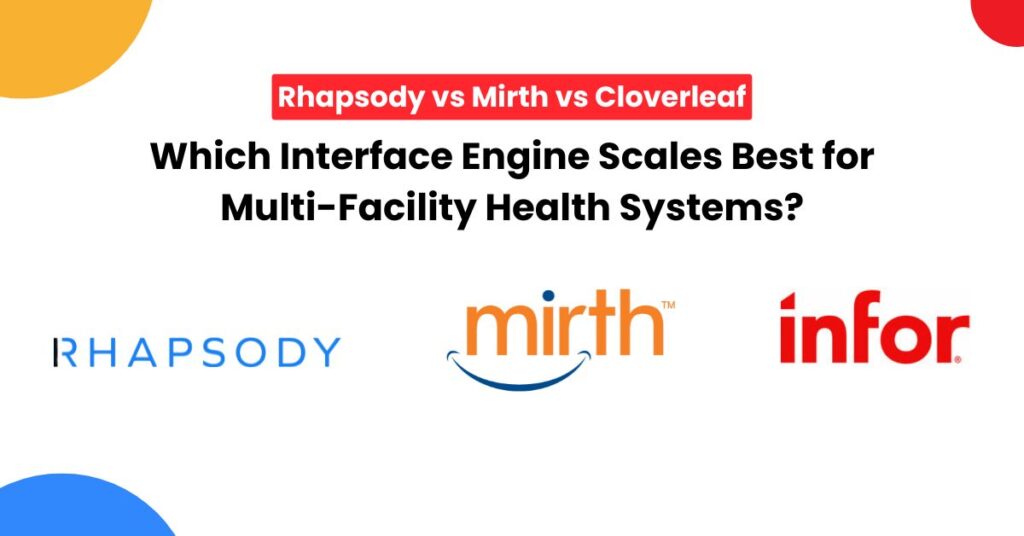Rhapsody vs Mirth vs Cloverleaf: Which Interface Engine Scales Best for Multi-Facility Health Systems?
Multi-facility health systems (multi-hospital networks and clinics) generate a huge volume of interoperability traffic. Interface engines for these organizations must handle high message throughput across many sites, while providing high availability and often multi-tenant management.
We compare three leading healthcare integration engines, Rhapsody, Mirth Connect, and Infor Cloverleaf, to see how each platform scales technically, architecturally, and in practice.
Overview of the Platforms
Rhapsody (Corepoint)
An enterprise-grade integration engine known for ease of deployment and reliable performance. Rhapsody offers a drag-and-drop interface and supports on-premises, cloud, or hybrid deployments.
Its subscription pricing and built-in multi-tenant “Locker” architecture allow one instance to serve multiple facilities without duplicating infrastructure.
Mirth Connect
An open-source integration engine (with a supported premium version) that handles HL7, FHIR, DICOM, X12, and more. Mirth’s flexibility and no-license cost make it very cost-effective.
It “scales from small clinics to large hospital networks” by deploying multiple instances or clusters, though very large deployments typically require setting up database clustering or various servers.
Infor Cloverleaf Integration Suite
A mature, enterprise-class engine for large-scale healthcare. Cloverleaf provides robust data transformation and real-time monitoring. It excels at very high volumes (thousands of interfaces) and complex workflows, but has higher cost and complexity.
Infor offers Cloverleaf both on-premises and as a cloud service; the AWS-based Cloverleaf Cloud is purpose-built for scalability and easier management.
Rhapsody vs Mirth vs Cloverleaf (The Ultimate Comparison)
1. Scalability and Architecture
Multi-Tenancy
Rhapsody’s Locker feature is designed for multi-tenant use. One Rhapsody server can manage multiple “customers” or facilities in isolation. This centralizes management and reduces infrastructure for large networks.
Mirth Connect has no native multi-tenant mode; very large deployments often run separate Mirth servers (and databases) per environment or use its clustering feature. Cloverleaf is historically deployed per organization, though cloud versions can serve multiple endpoints.
High Availability
All three engines can be configured for high availability. Cloverleaf supports active/passive clusters with automatic failover, and the cloud edition is inherently resilient. Rhapsody can be deployed in active/passive pairs or in container clusters to avoid downtime.
Mirth Connect provides clustering via a shared database and can use load balancers, but achieving enterprise-grade HA with Mirth typically involves additional components.
Throughput
Integration engines are often measured by messages/second. In lab tests, pass-through throughput reached ~1000 HL7 messages/sec on modern hardware. In practice, all three engines can meet large-scale demands if properly scaled.
Rhapsody and Cloverleaf are engineered for high volume; for example, customers report Cloverleaf handling vast transaction volumes reliably. Mirth Connect can also process high loads, but it requires careful scaling (e.g., multiple nodes) to avoid bottlenecks.
2. Feature and Cost Comparison
Licensing and Cost
Mirth’s open-source core means no software license fees, allowing inexpensive scaling by adding servers. Rhapsody and Cloverleaf require purchased licenses or subscriptions, which increase total cost but include vendor support.
Organizations must weigh budget: Rhapsody’s subscription (often fixed or usage-based) can simplify budgeting, while Mirth’s free core keeps scaling costs low but shifts effort to infrastructure and staffing.
Ease of Use
Rhapsody is often praised for its intuitive GUI and templating, speeding development across many interfaces. Mirth provides a graphical dashboard but relies on scripting (JavaScript) for transformations; it offers flexibility but can be steeper for non-programmers.
Cloverleaf’s IDE is powerful but typically requires specialist training. In comparative analyses, Rhapsody’s user-friendly design is cited as a key benefit for large integration projects.
Support and Community
Mirth has a large user community and many online resources. NextGen’s Mirth Premium adds professional support (including 24/7 help) and training.
Rhapsody and Cloverleaf include enterprise support packages. For example, Rhapsody highlights global 24/7 support and guided onboarding to accelerate implementation. Organizations scaling across sites often need this vendor support for troubleshooting and guidance.
Standards and Protocols
All three engines support standard healthcare data formats and protocols. Cloverleaf and Rhapsody typically have built-in adapters for newer standards (like HL7 FHIR and JSON APIs).
Mirth also supports FHIR (via extensions) and modern web services. It’s important to verify support for any specialized interfaces (e.g., certain EHR systems) before choosing, though each platform covers the major standards.
Real-World Examples
WVU Health System (Rhapsody Corepoint)
WVUHS, a 21-hospital system, needed to consolidate interfaces during mergers. The IT team replaced several legacy engines (including Cloverleaf) with one Rhapsody Corepoint instance.
As a result, interface development time fell by over 50%, and staff could focus on other projects. Corepoint’s visual interface and reusable templates enabled rapid scaling of interfaces across the system.
Penn Highlands Healthcare (Cloverleaf)
Penn Highlands upgraded its integration architecture by moving to Infor Cloverleaf Cloud. The CIO noted that Cloverleaf’s cloud platform would better support growth and add functionality.
Similarly, customers like Hermes Pardini Group highlight Cloverleaf’s “scalability, redundancy, and data security” as critical for meeting strict SLAs. These cases show Cloverleaf serving large multi-facility organizations with heavy data flows.
Large Health Network (Mirth Connect Premium)
In reported cases, a major hospital network used Mirth Connect Premium to integrate its EHR with external labs and pharmacies. After implementation, the network saw a 30% reduction in lab turnaround time, enhancing patient care.
A regional health information exchange also implemented Mirth to aggregate records from multiple EHRs, leading to more complete patient data. These examples illustrate how Mirth can scale in high-volume scenarios.
Benchmarks and Findings
Published tests show on the order of ~1000 HL7 msgs/sec in a simple pass-through scenario, so all three engines can handle large enterprise volumes with proper hardware.
- Industry rankings reinforce their positioning: KLAS Research’s 2024 report names Rhapsody/Corepoint as the top integration engine.
- Mirth Connect’s flat licensing means adding channels incurs no extra per-interface fees, making its software cost-effectively linear as you scale.
- Infor Cloverleaf’s cloud-native architecture emphasizes high availability and elastic scaling.
No single benchmark “winner” exists; each engine can meet demand if deployed correctly, but these data points highlight Rhapsody’s top market ratings, Mirth’s cost structure, and Cloverleaf’s enterprise HA design.
CapMinds Health Data Exchange Solution
Though Mirth Connect, Rhapsody/Corepoint, and Infor Cloverleaf are comprehensive platforms that enable interoperability between health systems, without seasoned expertise, implementations can become complex and time-consuming.
If you’re searching for the best Healthcare Data Exchange Solution, whether you need Mirth Connect, Rhapsody/Corepoint, or Infor Cloverleaf, CapMinds has you covered.
We empower healthcare organizations to adopt, configure, and optimize these interface engines to streamline Health Data Exchange.
Why choose CapMinds Health Data Exchange Solution?
- Our Technical Experts specialize in Mirth Connect, Rhapsody/Corepoint, and Infor Cloverleaf. We’ll guide you through each platform’s unique challenges and best practices, ensuring a smooth implementation.
- We thoroughly analyze your practice’s existing workflows to configure the chosen engine—Mirth, Rhapsody, or Cloverleaf, so that data mapping and transformation align perfectly with your systems.
- Whether you need lightweight Mirth Connect channels, Rhapsody’s multi-facility Locker setup, or Cloverleaf’s high-availability architecture, we customize every deployment to match your environment and goals.
- Our solutions help you reduce manual, time-consuming tasks, regardless of which engine you choose, boosting productivity and enhancing data accuracy across your organization.
- We offer very competitive pricing and solutions designed to minimize integration costs and eliminate manual errors, benefiting practices of all sizes and complexities.
Reach out to CapMinds Solution for the best Health Interoperability Solution, whether your organization needs Mirth Connect, Rhapsody/Corepoint, or Infor Cloverleaf.




